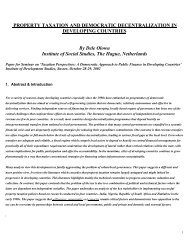View Article - Institute of Development Studies
View Article - Institute of Development Studies
View Article - Institute of Development Studies
You also want an ePaper? Increase the reach of your titles
YUMPU automatically turns print PDFs into web optimized ePapers that Google loves.
30a half years after their inception, all 15 ZPs and 325 AKPs were superseded. The APs andGPs remained moribund, and the UFG sought to bring about a truly comprehensive piece<strong>of</strong> PR legislation. This found shape in the WBP Bill (Bill No.42) <strong>of</strong> 1969. Introduced on9 th September, 1969 in the Forty-ninth session <strong>of</strong> the West Bengal Legislative Assembly,the Member-in-charge (MIC) <strong>of</strong> the Bill, Bibhuti Bhusan Dasgupta, sought to refer the Billto a 19 member Select Committee. In stating the objects and reasons for initiating the Bill,the MIC lashed out at the earlier Acts <strong>of</strong> 1957 and 1963; these denied the right to suffrageto the village folk, he maintained, and the working <strong>of</strong> these Acts failed to implement theDirective as enshrined in Act 40, <strong>of</strong> the Indian Constitution.It called for a three tier structure <strong>of</strong> PRIs, stating that ‘the long and persistent demandfrom the people <strong>of</strong> West Bengal has been to abolish the existing PRIs by repealing whollythe existing Panchayat Acts and to substitute them by real democratic structure..’. The Billremained un-enacted, for, the Second UFG fell in 1970 and President’s Rule was re-imposedin West Bengal.The WB panchayat Act <strong>of</strong> 1973 is the basis for rural decentralisation in West Bengaltoday, but echoes <strong>of</strong> the basic outlook and philosophy with which the Left front governmentin the State has been going along with its project <strong>of</strong> reforms can be traced back to the Bill<strong>of</strong> 1969. To a large extent, this Bill also influenced the Congress ministry which enactedthe West Bengal Panchayat Act , 1973, after coming to power in the polls <strong>of</strong> 1972. TheCommunist Party <strong>of</strong> India (CPI), with 36 seats, was the main opposition party in theHouse, when the Congress introduced the West Bengal Panchayat Bill, 1973. An interestingobservation may be made here about the political motive <strong>of</strong> the Congress-dominated Stategovernment in initiating this legislation. The point to be seized is that though the Congresshad a large number <strong>of</strong> seats, both in the WBLA and the National Parliament, the Leftrepresentation was very much palpable, spanning the tea plantations <strong>of</strong> Jalpaiguri to theseas <strong>of</strong> Sagar, from the industrial belt <strong>of</strong> Ranigunj-Asansol to the urban settings <strong>of</strong>Chandanagar, Behala and Jadavpur. In 1972, West Bengal’s Parliamentarians numbered40, <strong>of</strong> whom only 5 were from the Congress; the CPI(M) had 21 seats, the CPI 2, and theRSP 2. Thus, in terms <strong>of</strong> numbers and geographical spread, the left consolidation was inthe air.One may speculate that the Congress perhaps felt threatened, and as a step towardsensuring a support base for itself and warding <strong>of</strong>f the Left challenge, it tried to effect





